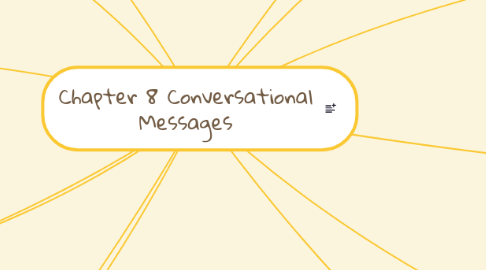
1. Conversation is Dialogic
1.1. Involves genuine two-way interaction
1.1.1. Dialogue—each person is sender, receiver, and listener
1.1.2. Monologue—one person speaks and the other listens
1.2. To increase dialogue
1.2.1. Show respect
1.2.2. Avoid negative criticism
1.2.3. Keep channels open
1.2.4. Avoid manipulation
2. Conversation is a Process of Turn-Taking
2.1. Speaker and listener exchange roles during conversation
2.1.1. Speaker Cues
2.1.2. Listener Cues
2.1.3. Backchanneling Cues
2.1.3.1. Indicate agreement or disagreement
2.1.3.2. Indicate degree of involvement
2.1.3.3. Pace the speaker
2.1.3.4. Ask for clarification
2.1.4. Interruptions
3. Conversation is (Usually) Polite
3.1. Conversation expected to follow the principle of politeness
3.1.1. Maxim of Tact
3.1.2. Maxim of Consideration and Generosity
3.1.3. Maxim of Approbation
3.1.4. Maxim of Modesty
3.1.5. Maxim of Agreement
3.1.6. Maxim of Sympathy/Empathy
4. Influences On Self-Disclosure
4.1. Your Personality
4.2. Your Culture
4.3. Your Gender
4.4. Your Listeners
4.5. Your Topic
4.6. The Medium
5. Guidelines for Self-Disclosure
5.1. Guidelines for Making Self-Disclosures
5.1.1. Disclose out of appropriate motivation
5.1.2. Disclose in the appropriate context
5.1.3. Disclose gradually
5.1.4. Disclose without imposing burdens on yourself or others
5.2. Guidelines for Facilitating and Responding to Others’ Self-Disclosures
5.2.1. Practice the skills of effective and active listening
5.2.2. Support and reinforce the discloser
5.2.3. Be willing to reciprocate
5.2.4. Keep the disclosures confidential
5.3. Guidelines for Resisting Self-Disclosure
5.3.1. Weigh the pros and cons of disclosing
5.3.2. Don’t be pushed
5.3.3. Be indirect and move to another topic
5.3.4. Delay a decision
5.3.5. Be assertive in your refusal to disclose
6. Guidelines for Giving a Compliment
6.1. Be real and honest.
6.2. Compliment in moderation
6.3. Be totally complimentary; avoid backhand compliments
6.4. Be specific
6.5. Be personal in your own feelings
7. Responding to Advice
7.1. Accept the advice
7.2. Avoid negative responses
7.3. Interact with the advice
7.4. Express appreciation
8. Principles of Conversation
8.1. A Developmental Process
8.2. Dialogic
8.3. A Process of Turn Taking
9. Conversation is a Developmental Process
9.1. Opening
9.2. Feedforward
9.3. Business
9.4. Feedback
9.5. Closing
9.6. Feedforward
10. Conversational Disclosure: Revealing Yourself
10.1. Communicating information about yourself with others such as
10.1.1. Your values, beliefs, and desires
10.1.2. Your behaviour
10.1.3. Your self-qualities and characteristics
10.2. People self-disclose
10.2.1. For catharsis
10.2.2. To help others
10.2.3. To encourage relationship growth, maintenance, or end
10.3. Must be received and understood by another individual
11. Self-Disclosure
11.1. Rewards
11.1.1. Self-knowledge
11.1.2. Communication and relationship effectiveness
11.1.3. Physiological health
11.2. Dangers
11.2.1. Personal risks
11.2.2. Relational risks
11.2.3. Professional Risks
12. Everyday Conversations
12.1. Small Talk
12.1.1. Casual, brief conversation that is pervasive in our daily lives
12.1.2. For more effective small talk
12.1.2.1. Be positive
12.1.2.2. Talk about noncontroversial topics
12.1.2.3. Be sensitive to leave-taking cues
12.1.2.4. Talk in short sequences
12.1.2.5. Dialogue, not monologue
12.1.2.6. Stress similarities
12.1.2.7. Answer questions with enough elaboration
12.2. Introducing People
12.2.1. A strong introduction introduces each person and gives the two something to talk about.
12.3. Apologies
12.3.1. Express regret and sorrow for something you have said or done
12.3.2. An effective apology is situation specific
12.3.2.1. Admit wrongdoing if necessary
12.3.2.2. Accept responsibility
12.3.2.3. Be apologetic
12.3.2.4. Be specific
12.3.2.5. Empathize
12.3.2.6. Give assurance
12.3.2.7. Avoid excuses
12.3.2.8. Choose the appropriate channel
12.4. Complimenting
12.5. Giving Advice
12.5.1. Listen
12.5.2. Empathize
12.5.3. Be tentative
12.5.4. Ensure understanding
12.5.5. Keep it confidential
12.5.6. Avoid should statements
